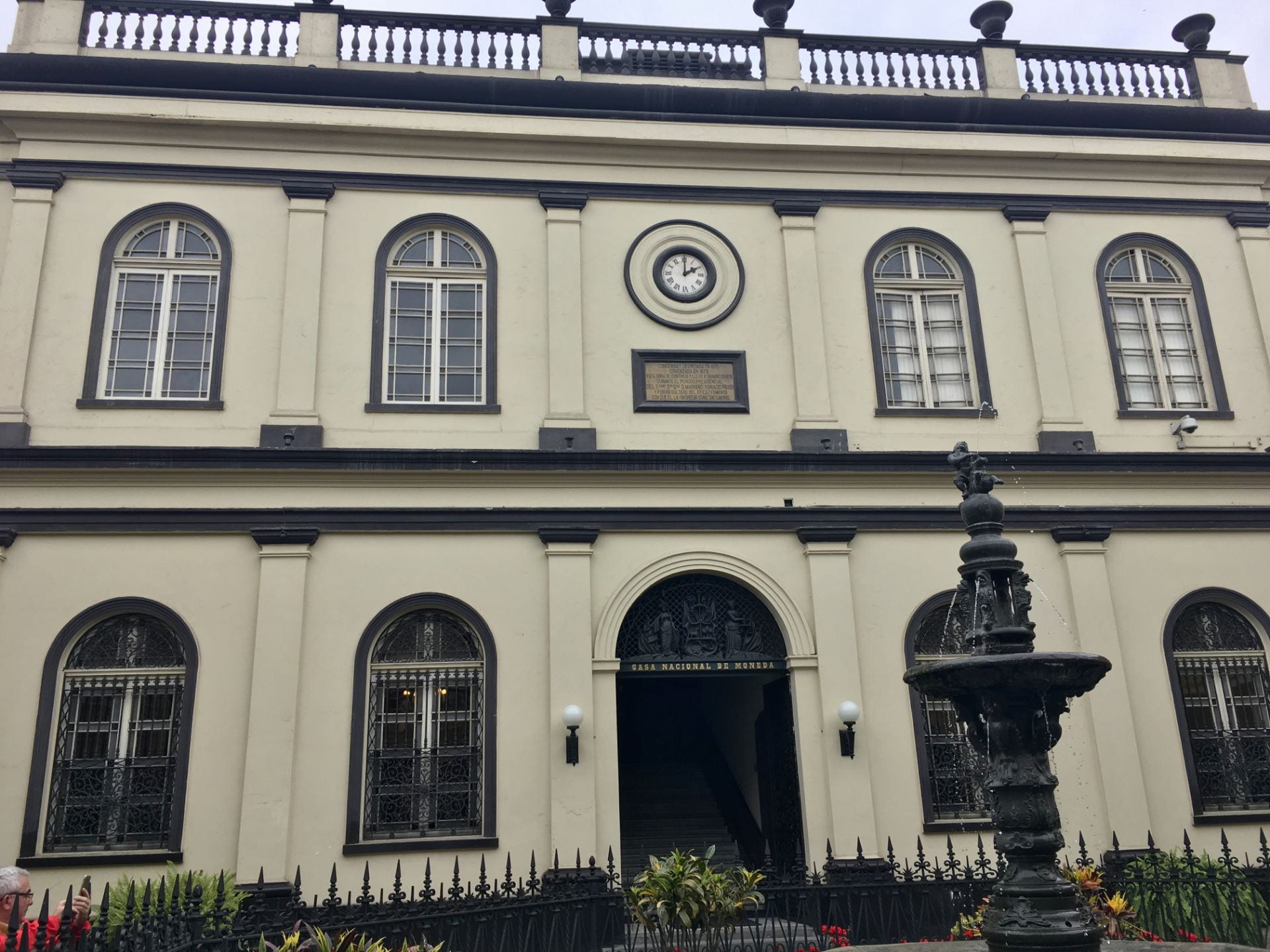Slavery Upstairs, Slavery Downstairs
Forced Labor in the Royal Mints of the Colonial Andes
On February 14, 1800, someone slipped an anonymous letter to the solicitor general of Lima’s high court via one of his domestic servants. When he opened it, the solicitor (fiscal) found a denunciation of sin and scandal concerning a Black family. The family patriarch, José Joaquín Hernández, worked as an enslaved master artisan in the foundry of the city’s Royal Mint, just six blocks from the solicitor’s office on the city’s Plaza de Armas. The complainant accused Hernández of living counter to both God’s law and the King’s (AGNP Colección Moreyra y Matute, D1. 29-797, February 14, 1800, 10-11).
Despite his enslavement, Hernández was said to be supporting a bigamous family living within the mint by pilfering silver from the coining process. The complainant further stated that Hernández had used this silver to purchase the freedom of one of his two wives, Josefa Gómez, her 14-year-old son Melchor and an unnamed six-year-old daughter of the other wife, Teresa García. Noting simply that the denunciation did not pertain anyone in his own household, the solicitor general forwarded the complaint without further comment to the mint treasurer.
How could such a scandal occur so close to the heart of royal power in the late colonial Andes? How did issues of race, class and slavery intersect in the royal mints? Exploring the lives of laborers and the way that labor was organized in the Royal Mints of Lima and Potosí (then part of Peru, now in today’s Bolivia) challenges assumptions about slavery and socioeconomic differentiation in colonial Latin America.
The plantation model of slavery epitomized by the antebellum U.S. South and practiced in Cuba, Brazil and other regions in Latin America and the Caribbean, long dominated 20th-century scholarship and public opinion about slavery. Scholars pointed out the brutality of conditions working in the fields of cotton, sugar and tobacco plantations and occasionally drew contrasts with the often lighter-skinned (or mixed-race) enslaved domestic laborers who worked in the big house.

This is a diorama of workers in the foundry (sala de fundición) located in the Museum of the Potosí Mint (Museo de la Casa de la Moneda). The figures depicted are intended to be interpreted as indigenous Andean (rear) and an Afro-descendant man (front) operating bellows to fan the flames of the foundry. Their job was to melt silver bars and alloy them with a precise copper mix to form longer, thinner “rails” for cutting into coins. This is the author’s photo, taken in October 2018.
Rarely was the urban enslaved population given serious thought. This produced a somewhat homogenous and static vision of slavery, which has been richly challenged in recent decades by studies of urban slavery, Black-indigenous relations and non-plantation labor in the Andes. Yet, we still lack a full picture of how slavery coexisted with other labor forms and in proto-industrial spaces like the huge mint complexes at the heart of the cities of Lima and Potosí.
Upstairs, downstairs provides a useful framework for exploring how the histories of forced labor in the royal mints challenge these assumptions of a static, rural, agricultural model for slavery. Forced labor was dynamic, diverse and connected to notions of class in complex ways. Slavery coexisted with other forms of forced labor both upstairs and downstairs, and laborers fought to shape their lives in ways meaningful to them with varying degrees of opportunity and success.
A mint is, first and foremost, the site where money is made. The mints in Lima and Potosí produced millions of pesos, reales and other denominations of coin that circulated across the early modern world between 1568 (when the first mint began production in Lima) and 1825 (when Peru and Bolivia became independent and ceased coining with the image of the King of Spain). In a sense, these sites enabled class divisions by producing the money that elites spent or hoarded to project images of nobility and acquire power over others. A family who directed the Potosí mint at various points was awarded the noble title “Count of the Mint” (Conde de la Casa de Moneda), and the Count of San Juan de Lurigancho governed the Lima mint as a monopoly in the late 17th and early 18th centuries.

The second and principal patio of the Potosí Mint, built between 1756 and 1773. The lower floor housed public-facing offices for reception and dispatch of silver, assay, and treasury. Today it is home to various stops on the museum tour as well as the Potosí Historic Archive (Archivo Histórico de Potosí) The upper floor housed private lodgings for mint officials and now is home to various stops on the tour and a display of the city’s historic art. This is the author’s photo, taken in October 2018.
At the same time, men of African and indigenous Andean descent were the primary workers producing this coin under situations of slavery and other forms of coercion that preserved the power structure. Upstairs, downstairs is both literal and metaphorical. The mint buildings still standing in both cities were built in the mid-18th century and designed by the same architect. They feature two floors surrounding two central patios. Production occurred primarily around the second (interior) patio, and downstairs on the first patio, which was ringed by public offices for reception and discharge of bars and coin. On the upper floor, comfortable lodgings housed the most important mint officials and their families.
Downstairs, then, was where forced laborers worked in coining. Records in the Municipal Historic Archive of Potosí (AHP) and the General National Archive of Peru (AGNP) identify hundreds of laborers working at one time to inspect, alloy, mold, cut and strike millions of coins each year. By the late 18th century, Lima’s mint produced about five million pesos worth of silver coin and another half million in gold, with Potosí’s just behind at about 4.5 million in silver and a half million in gold (John Jay TePaske, A New World of Gold and Silver, Boston: Brill, 2010, 238, 245).
Conditions were harsh. Enslaved Africans and Afro-descendants comprised most of the manual workforce in 17th-century Potosí and across the life of the Lima mint, working alongside those of indigenous and European descent. These men did the hammering and cutting to produce the rough, “macuquina” coins in both locations until the mid-18th century. In Lima, they also alloyed silver with copper in the foundry, bleached blank coins, carried heavy loads, cleaned the mint and performed other duties. Potosí also counted on the forced labor of indigenous Andeans. For the life of the mint, the Potosí foundry (where silver and copper were alloyed to produce long, thin rails) was manned by yanaconas, indigenous Andean servants in a paid but forced position that has been compared to European serfdom. Other offices were staffed with a mix of enslaved, penal and wage labor, with Europeans sometimes among the latter groups.
Around the turn of the 18th century, prior to the construction of the new buildings and reforms to the coining process, the labor picture was becoming even more complicated. Lima’s authorities continued to rely on enslaved labor, but often paid day wages to jornaleros, enslaved men who worked for a day wage and had to turn over part or all of it to the enslaver, a private party unconnected to the mint. Other mint officials continued to purchase the labor of enslaved people. Meanwhile in Potosí, convict labor was becoming the majority of the workforce as the mint’s internal tribunal and others throughout the region sentenced men to hard labor in the mint to punish robberies and violent crimes. Many of these were described as indigenous Andeans or mixed race mulatos and mestizos, and they worked alongside enslaved Afro-descendants in coining and building construction.
As the new buildings were built, administrators imported mechanized mills to punch out the blank coins and new presses to make stamping the king’s image easier and more accurate. But the mechanized processes still required manual labor and demanded new types of work. Manual laborers loaded, unloaded and operated machines; guided and cared for the mules that powered the mills and performed other new duties.

The façade of the Lima Mint (Casa de la Moneda de Lima), built between 1746 and 1761. The front offices on the lower floor would have been for the guards, with lodgings for officials on the upper floor. Today the building is home to a museum about minting and situated immediately adjacent to the currently operating Lima Mint. This is the author’s photo, taken in October 2018.
While these were difficult, coerced positions lifting heavy loads and tools, working with extremely hot fires and in cold, stone buildings; proximity to wealth (and the wealthy) meant that class and race sometimes mapped unevenly onto these positions. For example, a Spanish convict laborer fled the Potosí mint in 1667 to petition before a notary for better treatment. He complained that the slaves wielded too much power in his workshop and treated him unfairly (AHP, Casa Real de Moneda 1366, 1689). Reduced by criminal sentence to a subordinate position, the Spaniard was supervised by enslaved men of African descent.
Outside of the oversight of sometimes lax officials, workers downstairs were sometimes able to exercise relative autonomy. A century later, the anonymous complaint denounced José Joaquín Hernández for siphoning off silver from the foundry to purchase the freedom of his family and provide them with material support. Hernández challenged his enslaved status to provide for his family. Forced mint labor sometimes upended racial or class hierarchies, and those subjected to it worked hard to carve out autonomy for themselves.
Upstairs, opportunities and risks abounded as well. In the apartments above the mints’ workshops and offices, enslaved Afro-descendants and Andean servants cooked, cleaned and cared for resident mint officials. This domestic work sometimes afforded these workers greater privileges or mobility than for those working downstairs. The resident Lieutenant Governor of Potosí granted conditional manumission to “the Black Slave Manuela” in 1793 to reward the great care Manuela showed the enslaver’s wife during an illness. But Manuela’s freedom grant required that she serve the family for ten more years. Such promises often ultimately went unfulfilled or required an uprooting of the conditionally free person’s life if the enslaver was stationed somewhere else (AHP, Escrituras Notariales 179, June 5, 1793. 351v-352).
Others faced suspicion because of the degree of access they had to authorities. Discovering a robbery had occurred, an official in the Lima mint seized the first person he stumbled across in his dark lodgings in 1756, only later identifying him as his own enslaved servant, Jacinto Matute. The innocent Matute was dragged in chains to a commercial bakery (brutal sites of labor and punishment in the 18th century) and whipped mercilessly until he named another suspect (AGNP, Colección Moreyra y Matute, D1. 83-195, 1756, 1-2). Personal service and fidelity went unrewarded more often than they garnered manumissions.
Forced labor produced the money and the division of work essential to creating class privilege in colonial Latin America. But what of internal divisions among forced laborers? Did enslavement, racial classification or class division determine status?
The reality is complex. Enslaved people and other forced labors existed in liminal positions. Access to money in coining work and requirements to care for elite Spaniards might garner privileges or (rarely) even manumission for the enslaved, but usually required careful saving and exhaustive work. Others were worked to death in the grueling coining process or had their lives uprooted when sold or moved out of the mint. As the Spanish convict laborer complained, the enslaved were sometimes trusted with positions of responsibility and oversight, yet their forced labor had no expiration like date like his did. Convict laborers could leave the mint or stay on for wage work after completing their sentences, though they sometimes had to fight for enforcement of their freedom.

A set of historic presses for stamping coins on the first patio of the Lima Mint. This is the author’s photo, taken in October 2018. Workers used these in the final step of the coining process to engrave blank coins with the image of the king.
For Andean workers, even those not bound by yanaconaje or penal work, wages were low and often required holding multiple jobs, putting children to work or pocketing silver just to get by. Officials in both mints complained that the low wages they were authorized to pay for free positions only attracted plebian men, whom they accused of being complicit in or willfully ignoring thefts by forced laborers. Harsh labor discipline and a private jurisdiction allowed officials to convict free workers of crimes, converting them into convict laborers.
Life in the royal mints carried greats risks for forced laborers, whether working upstairs or downstairs, and those who carved out privileges worked hard under constant peril of losing them.
James Almeida is a Ph.D. Candidate in Latin American History at Harvard University. For more on forced labor and race in the royal mints, see his article, “Suspicion Possession: Policing Silver and Making Race in Colonial Potosí” available at https://doi-org.ezp-prod1.hul.harvard.edu/10.1080/10609164.2021.1996991.
Related Articles
Editor’s Letter
Editor's Letter Upstairs, Downstairs (and In-Between)When Argentine biologist Otto Solbrig was interim DRCLAS faculty director many years ago, he commented more than once that ReVista did not feature enough photos of middle-class people. I tried to respond to his...
Paid Domestic Workers, Women and Democracy
I first visited Peru in 1995 as a graduate student and junior member of a Latin American Studies Association delegation to examine the state of democracy in that country on the…
Invisible Commutes
English + Español
Belén García, a Colombian domestic worker, wakes up at five in the morning every day in her home in the chilly mountains of southeastern Bogotá. After taking a shower, she dresses in several…



